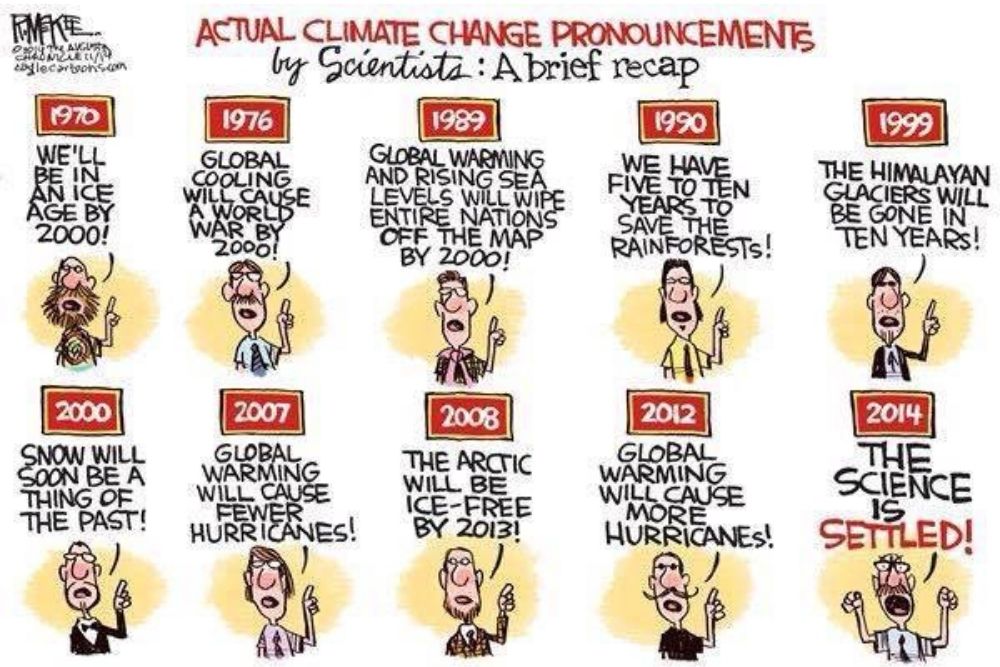The number 26 in COP26 is the number of times this indulgent conference has been held, replete with failed predictions of doom. If you haven’t noticed, there is a trend here and in a few short paragraphs, I will try and give you a flavour of the agenda.
Firstly, the media gushes over sensational headlines which once sold papers and now drive clicks, therefore potential ad revenue. Second, the IPCC was created in 1988 and took control (through funding) of key influential meteorological and academic organisations around the world. Third, the IPCC set about creating a
science community within its walls that had an apparent purpose to construct evidence that CO2 emitted by humans caused increasing temperatures. Of course, the scientific method of engaging in robust academic discourse was thoroughly cleansed (remember David Bellamy?). Scientists are not to challenge the UN hypothesis. And there remains the observed objective of erasing investment from fossil fuel industries.
So why so many conferences? Well, as with many government departments, there is a need for the UN needs to justify its existence, and now, after years of ![]() failed predictions, it can be reasonably argued that the need to keep resetting the agenda justifies such an existence, with visible action of some sort, of course.
failed predictions, it can be reasonably argued that the need to keep resetting the agenda justifies such an existence, with visible action of some sort, of course.
Getting back to COP26, two big media announcements in the first week were:
1. 200 countries agreed to cut Methane emissions by 30% by 2030
2. Many countries said they would end the use of coal for power generation by 2030
Let’s take them one at a time:
1. Methane is considered a greenhouse gas, as is carbon dioxide and water vapour. There is no disagreement on that fact. What is not often mentioned, however, is that methane is an infinitesimal 0.18% of the greenhouse gases. Yet the Climate Commission’s report for New Zealand is to cull herds by 15%. Keep in mind that there are
already excellent science options being developed ![]() by AgResearch to reduce farm animal methane emissions using new bio feed methods.
by AgResearch to reduce farm animal methane emissions using new bio feed methods.
2. Coal, natural gases and oil account for approximately 80% of the world electricity production and energy demand. Wind and solar currently account for 3% of production, are intermittent and have much lower efficiency; and this is despite billions of dollars spent and subsidies applied with taxpayer’s money over the last 30 years. Turbines don’t work when the wind isn’t blowing and solar is ineffective at night. We need fast reliable backup generation options; our choices are gas, coal or nuclear.
New Zealand is extremely fortunate in being able to source 80% of electricity from hydroelectric dams. Many other countries either do not have the natural resources or have a much higher population density to support. Accordingly the French and English are currently approving the building of new nuclear power stations, not least due to the European energy crisis driven by solar/wind source failures and gas price increases. It is notable that they have gone to Glasgow with halfhearted, unbinding pledges.
As for New Zealand, the Greens, and to a lesser extent Labour, oppose expanded hydro, coal, natural gas or nuclear power sources as generation options. That only leaves biomass (wood chip burning), wind and solar.

North Sea Wind Turbines
Frankly, I don’t think New Zealanders want to see these monstrosities peppering our shores or on our pristine bush-clad
coastlines. And we just don’t have enough landmass to build massive solar farms.
Despite all the rhetoric and pledges made at COP-26, delegates will go home and be faced with the realities of their own country’s energy needs. If they don’t keep the lights on they may not be in power at COP-27; they will likely use whatever resources make short term sense, like importing 150 truckloads of coal a day from Indonesia to keep Huntly Power Station running because The Green Party banned natural gas exploration in Taranaki.
This inanity expands to absolute ludicrosity when you consider New Zealand has 5 billion tons of unused coal in the Waikato and West Coast.
By The Climate Realist.
Image by Rick McKee.










